Background
There are three species of bluefin tuna in the world: Pacific bluefin tuna, Thunnus orientalis; Atlantic bluefin tuna, Thunnus thynnus; and southern bluefin tuna, Thunnus maccoyii. Pacific bluefin tuna, T. orientalis, is the largest fish in Scombridae, and the maximum length and weight recorded in the Pacific Ocean are about 300 cm and 555 kg, respectively. According to the experiment by Shimose et al. (2009), the high growth rate of T. orientalis during the first 5 years allows them to attain the body length around 150 cm, and the rate gradually decreases thereafter. However, the growth, in general, stops at the age of ten, and the longevity exceeds 20 years. The size of a male T. orientalis is larger than that of a female in the older age groups, and this is caused by the differential growth rates between the sexes. Harada (1980) stated that spawning of T. orientalis occurs at the age of about 5 years when it reaches around 150 cm in FL and 60 kg in weight. Two main spawning grounds of T. orientalis had been identified to be in the southwestern North Pacific, one off east Taiwan and one in the south of the East Sea (Okiyama 1974; Chen et al. 2006; Tanaka et al. 2007), but currently, there is no evidence for any local stocks in both spawning regions (Shimose et al. 2009). T. orientalis is a highly migratory species occurring throughout the North Pacific Ocean ranging from the East Asian coast to the western coast of North America and is also recorded as a visitor to the South Pacific (Collette 1999; IUCN 2014). The fish maintains higher body temperatures than ambient temperatures; therefore, this ability would enable them to be distributed widely in the ocean (Carey and Teal 1969; Graham and Dickson 2004). T. orientalis often repeats vertical movements below the thermocline in the daytime, although the fish spends most of the time swimming within the surface mixed layer (Kitagawa et al. 2007).
Also, this species feeds on round herring, pompano, mackerel, saury, skipjack tuna, and sardine (Kida 1936; Doi 1960; Yokota et al. 1961). T. orientalis competes with albacore, yellowtail, barracuda, and mackerel over food (Bell 1963). Yokota et al. (1961) mentioned the presence of juvenile T. orientalis in the stomachs of skipjack. Yamanaka (1963) stated that the immature has many predators such as seal, dolphin, spear-fish, swordfish, and shark.
The catch of T. orientalis in the Pacific Ocean as well as the world is much less than that of skipjack, yellowfin, and albacore tuna (FAO 2010). Nevertheless, the commercial value of this species exceeds that of other tunas (The Pew Charitable Trusts 2016). The catch of T. orientalis of the Korean fisheries fluctuated annually, which had been at a very low level until the end of the 1990s but increased thereafter. In the case of the North Pacific, it showed the similar trend with the total catch of Korean waters.
Recently, the climate has been changed rapidly, and ocean ecosystems also respond to this change (Hollowed et al. 2011). Many scientists have carried out research about the relationship between climate change and fishery because climate change such as global warming and ocean acidification became a serious issue in the ocean ecosystems. The variation in temperature, wind field, and precipitation has an influence on the ocean’s water properties, which sequentially impacts on ocean ecosystem including fish stocks (Drinkwater 2005). Lehodey et al. (2003) stated that the recruitment of tuna species in the Pacific was correlated with the climate indices such as Southern Oscillation Index (SOI) and Pacific Decadal Oscillation Index (PDOI).
Few studies on the fishery and ecological characteristics of T. orientalis in Korean waters have been conducted, although T. orientalis was recognized as a commercially important species. For the sustainable yield of T. orientalis with the proper stock assessment and management, the ecological research on the distribution of fishing ground and basic biological characteristics should be conducted. Therefore, the aim of this study is to investigate the fishing grounds of T. orientalis around Jeju Island of Korea to identify the relationship between the fishing characteristics of T. orientalis and environmental factors.
Methods
In this study, T. orientalis fishery-related parameters were collected from the Korean large purse seine fisheries around Jeju Island. The catch and effort (the number of sets) data used in the study area were obtained from Busan Cooperative Fish Market (BCFM) and fisheries cooperatives radio station during 2004–2013. Catch per unit effort (CPUE) of T. orientalis was calculated based on the catch divided by the number of sets. Fork length (FL) of T. orientalis was measured from about 38,000 by the field survey in BCFM during 2004–2013(Table 1). The annual catch data from 2010 to 2013 in Korean waters came from Korean Statistical Information Service (KOSIS, http://kosis.kr/statisticsList/statisticsList_01List.jsp?vwcd=MT_ZTITLE&parentId=F#SubCont), and the data before 2009 was revised value by calculating the actual weight of T. orientalis per box. And those in the North Pacific were obtained from the International Scientific Committee for Tuna and Tuna-like Species in the North Pacific Ocean (ISC, http://isc.fra.go.jp/working_groups/pacific_bluefin_tuna.html) during 1982–2012 to figure out the trends of the annual catch.
The habitat conditions such as seawater temperature, salinity, and dissolved oxygen were examined by bi-monthly information collected through oceanographic surveys (Fig. 1). This oceanographic data from 2004 to 2013 were obtained from the Korea Oceanographic Data Center (KODC). We assumed that seawater properties at the surface and 50 m off Jeju Island represent the habitat characteristics of T. orientalis because T. orientalis spend most of the time in the mixed layer with the exception of frequent dives (Kitagawa et al. 2000). Annual sea surface temperature (SST) collected by Moderate Resolution Imaging Spectroradiometer (MODIS) satellite during 2004–2013 was investigated to identify the seawater temperature at the fishing ground. In addition to seawater properties, several monthly climate indices such as Pacific Decadal Oscillation Index (PDOI) and the Arctic Oscillation Index (AOI) were selected to correlate with month average of catch and FL of T. orientalis using SPSS software. PDOI is the leading empirical orthogonal function (EOF) of monthly sea surface temperature anomalies over the North Pacific (poleward of 20° N) after the global average sea surface temperature has been removed (Deser et al. 2010). And AOI is a low-frequency mode of atmospheric variability of the southern hemisphere. It is defined as a belt of westerly winds or low pressure surrounding Antarctica which moves north or south as its mode of variability (Australian Bureau of Meteorology 2013). Those climatic indices were collected from http://jisao.washington.edu/pdo/PDO.latest and http://jisao.washington.edu/ao/#data, respectively.
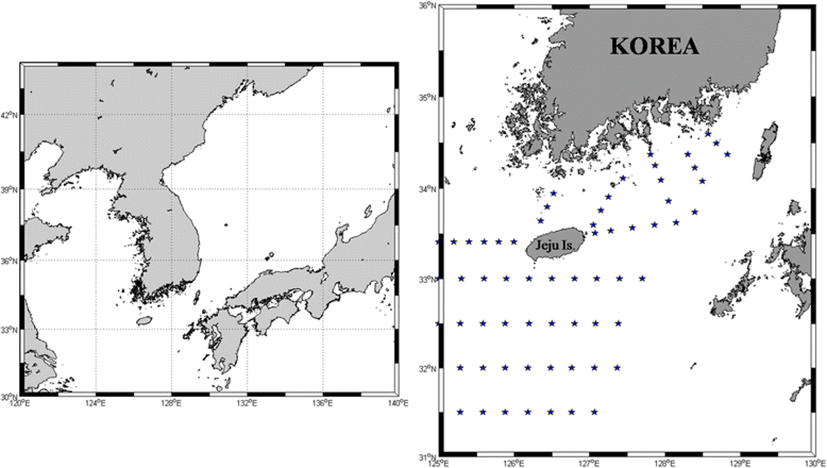
The joint confident region on the fishing spot of T. orientalis (long., lat.) was analyzed to determine the distribution area of T. orientalis in the study area (Yang et al. 2012). Joint confident region indicates the ellipse which has the major axis (λ1) and the minor axis (λ2). The formula for calculating the ellipse is as in the following:
where s1 and s2 are the standard deviation of X and Y, and s12 is the covariance. Formula 2 is to analyze the slopes of the major axis (b1) and the minor axis (b2) which indicate the direction of the ellipse.
Results
Mean seawater temperature at 50 m was low in the first half of the year but increased in the second half of the year (Fig. 2a). The catch and the FL of T. orientalis in the first half of the year (i.e., winter and spring) were higher than those in the second half (i.e., summer and fall) (Figs. 3b and 4b). The time series of annual seawater temperature indicated that year 2007 was relatively the warm period, whereas year 2011 was relatively the cool period (Fig. 2a). The catch of T. orientalis in 2007 was double than those in 2011 (Fig. 3a). Also, the PDOI was generally high from winter through spring and comparatively low from summer through fall (Fig. 2b). In the case of annual PDOI, when the PDOI had a low value such as in 2008, the catch of T. orientalis was high. From 2004 to 2005, however, when the PDOI had a relatively high value, the catch was low (Fig. 3a).
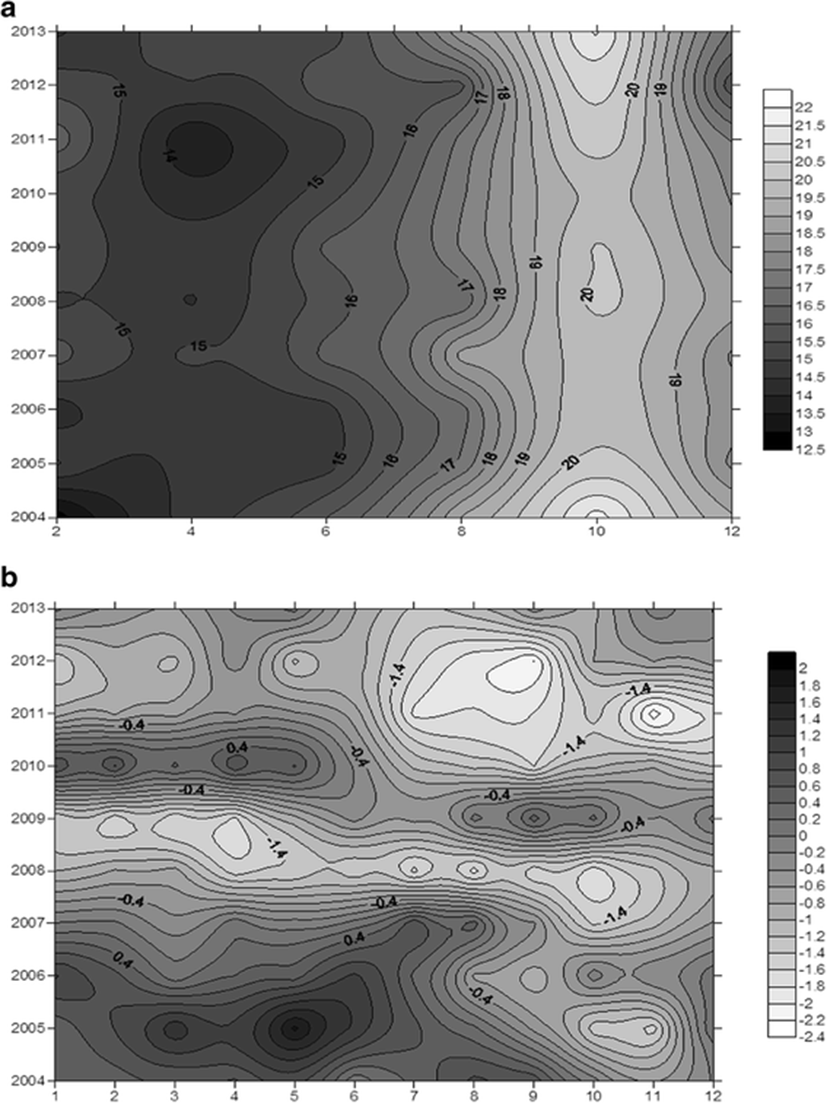
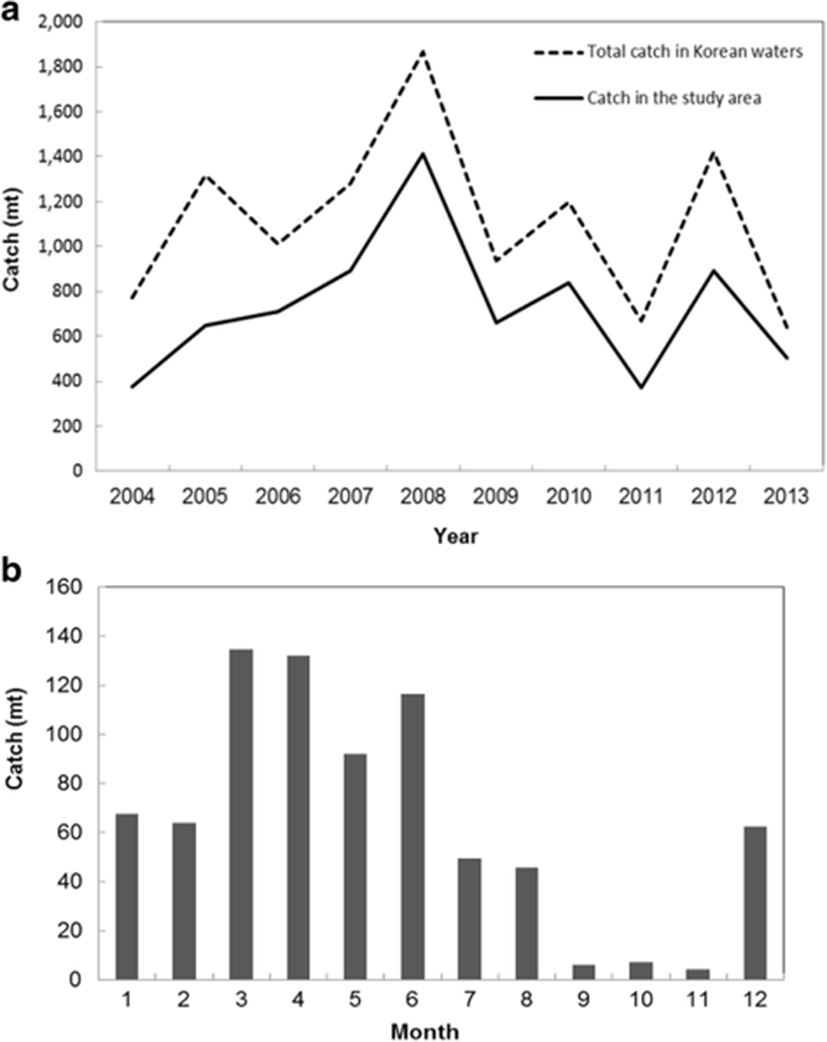
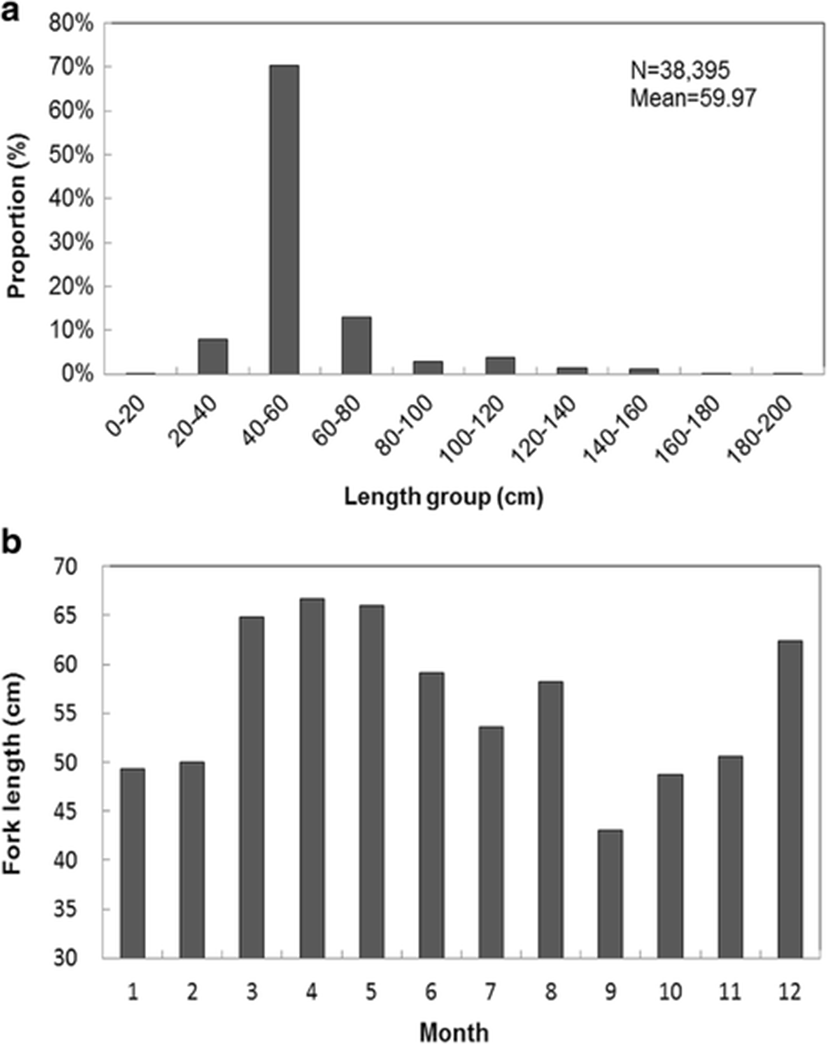
The annual catch of T. orientalis in the North Pacific Ocean had continuously fluctuated during 1982–2012 (Fig. 5a). It demonstrated the low catch (about 10,000 t) in the late 1980s through the early 1990s, and a relatively high level of catch (about 20,000 t) maintained from the mid-1990s to the mid-2000s. The annual catch of T. orientalis reached the highest (33,000 t) in 2000 and showed a general tendency of decrease thereafter. In Korean waters, the annual catch of T. orientalis started 31 t in 1982, and it showed less than 1000 t until the end of the 1990s (Fig. 5b). The catch recorded 2400 t in 2000, and it hit the record (2600 t) in 2003. The catch has generally decreased since 2003 with a minor fluctuating pattern. The annual catch trends of T. orientalis from the Korean waters, and the study area seemed to be parallel during 2004–2013 (Fig. 3a). It had increased continuously from 350 t in 2004 to 1414 t in 2008 and then tended to decrease reaching 500 t in 2013. Monthly variation of T. orientalis indicated that high catches were recorded in spring to early summer while very low catches in fall (Fig. 3b). The catch in March through June occupied about 60% of the total, and the mean catch in March was the highest (135 t) and continuously decreased to fall. Catches in September to November were only about 2% of the total catch.
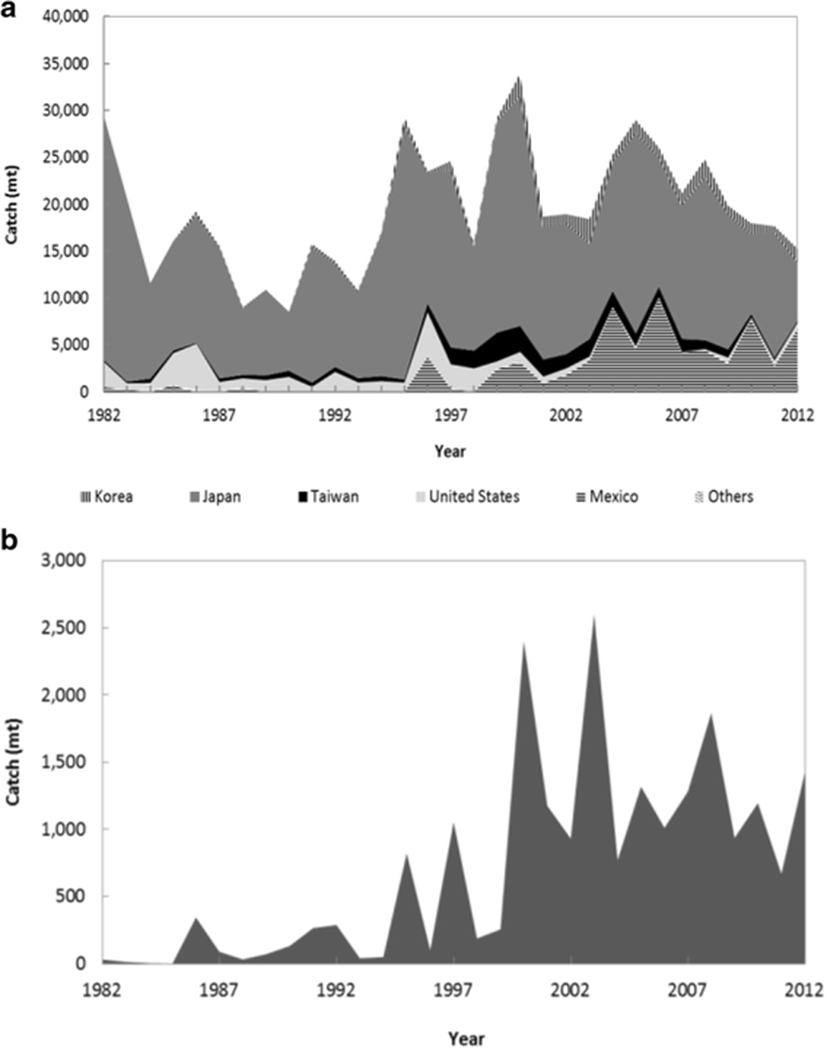
T. orientalis caught from the study area during the 2004–2013 period showed the FL range of 19–293 cm with the mean of about 60 cm (Fig. 4a). Length frequency graph revealed that the length mode of 40–60 cm accounted for 70% of the total. The second and third largest ones in proportion were the length groups of 60–80 cm (13%) and 20–40 cm (8%), respectively. Monthly mean length of T. orientalis indicated that the larger sizes were found in spring (i.e., 66.7 cm in April) (Fig. 4b). In general, smaller sizes appeared in fall (i.e., 43 cm in September).
The range and direction of the joint confident region (i.e., ellipse) were analyzed in every year based on catch information, and the locations of ellipse were overlapped to the SST distribution in the study area (Fig. 6). Most ellipses located on the east side of Jeju Island and the major axis of ellipses seemed to parallel (i.e., east-west direction) to the flow direction of Tsushima Current. Distribution of fishing ground matched with the specific annual temperature ranges observed by MODIS satellite. For example, in 2004, the main fishing ground of T. orientalis was distributed over the SST range of 19–20 °C, and temperature information in other years also showed the similar ranges. In general, the locations of main fishing areas seemed to be in SST ranges of 19–23 °C off Jeju Island during 2004–2013.
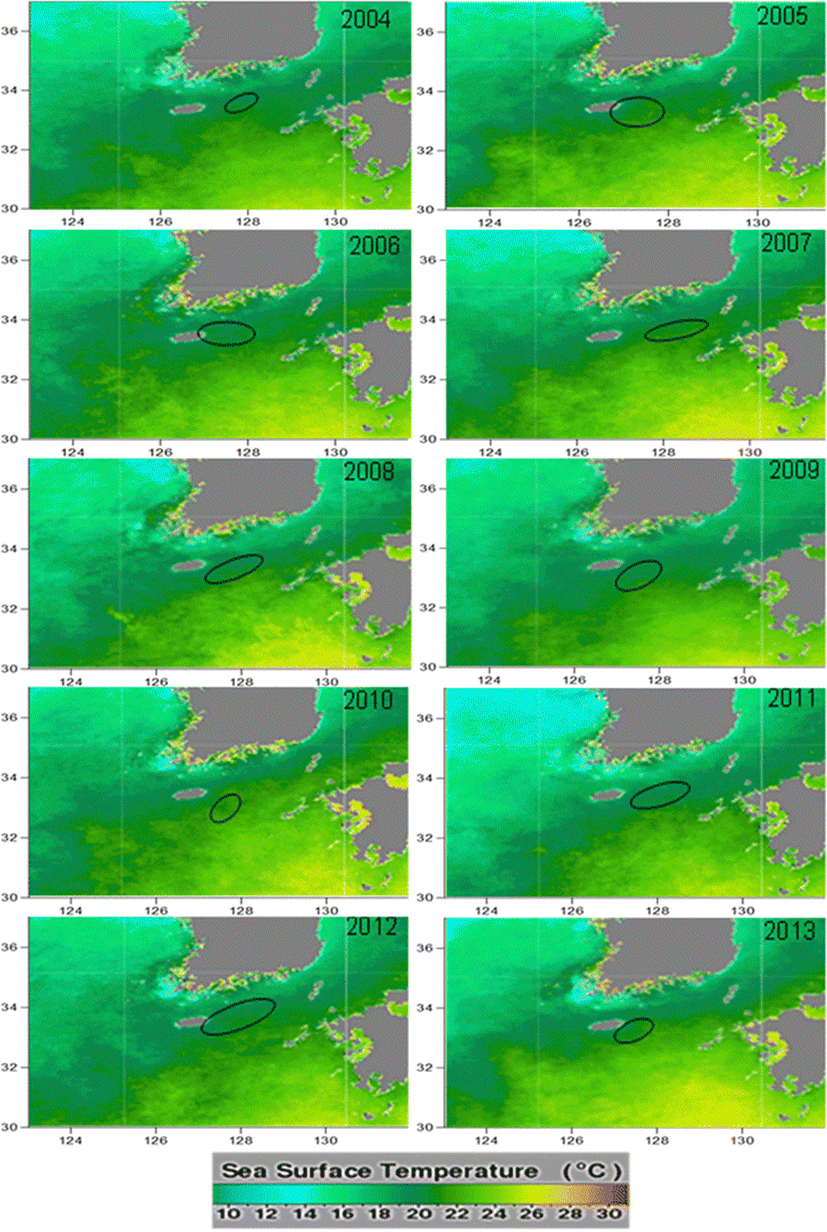
The environmental, fisheries, and biological data were statistically examined using correlation analysis (Table 2). Since the PDOI, catch, and FL showed higher values in the first half than the second half of the year (Figs. 2b, 3b, and 4b), while seawater temperature at 50 m revealed the opposite pattern (Fig. 2a); the PDOI has significant positive correlations with monthly mean catch (r = 0.856, p < 0.01). Seawater temperature at 50 m showed negative correlations with monthly mean catch (r = − 0.755, p < 0.01) and monthly mean FL (r = − 0.592, p < 0.01 for). The lower the temperature at 50 m in depth was, the higher the catch and the bigger the length of T. orientalis became. On the other hand, there were no significant correlations between catch and length with environmental factors such as salinity, dissolved oxygen, and AOI.
The numbers used for the climate indices (i.e., PDOI and AOI) and the seawater properties (temperature, salinity, and dissolved oxygen) were 12 (monthly) and 6 (bi-monthly), respectively
**Indicates the significant level of 0.01
Spatial distribution of CPUE of T. orientalis overlapped with the mean temperature at 50 m during the period of 2004 to 2013 (Fig. 7). In February, the mean temperature at 50 m of the study area was about 15.5 °C, and CPUE was lower than the other season and had high value (1–2 t/set) near 16 °C isotherm. In April, the mean temperature at 50 m was similar to February, but CPUE was found to be over 10 t/set in the 15 °C isotherm. In June, the mean temperature at 50 m was about 16 °C, and CPUE was high (1–7 t/set) in the temperature of 15–16 °C. Seawater temperatures were increased until August, and the CPUE also maintained in high levels (1–11 t/set). However, in October, the mean seawater temperature at 50 m marked the highest (about 21 °C), and CPUE sharply dropped below 1 t/set. In December, seawater temperature was decreased to about 19 °C, and CPUE was again increased to 18.8 t/set.
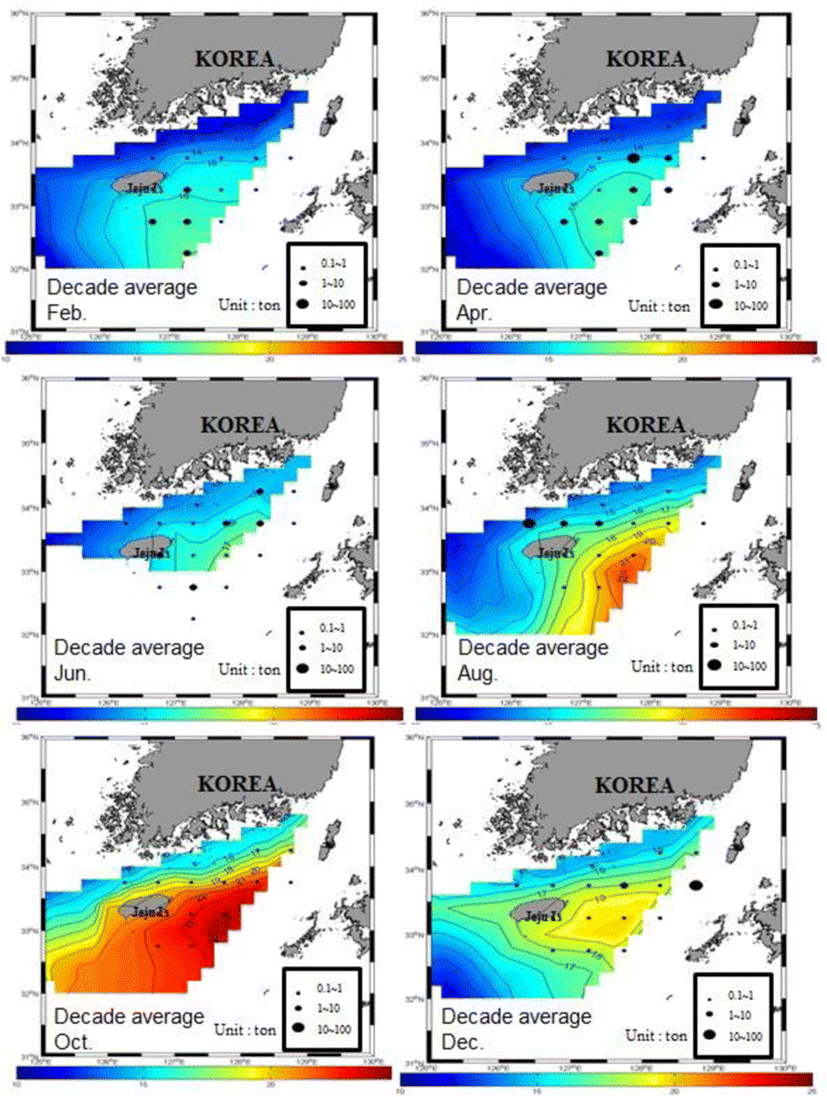
Discussion
The annual total catch of T. orientalis had fluctuated in Korean waters from 2004 to 2013. The catch of T. orientalis in the study area had occupied about 50–80% of the total catch. Also, this study area is regarded as the main fishing ground of T. orientalis in Korean waters. Therefore, we assumed that the fishery and ecological characteristics of T. orientalis caught in the study area could represent those of T. orientalis lived in Korean waters. We analyzed how variations in environmental factors and climate indices in the study area have effects on the catch and the length of T. orientalis. The monthly mean catch and length of T. orientalis in this study showed a strong seasonal difference, and most of T. orientalis caught around Jeju Island ranged 40–60 cm that was classified as an immature (Yukinawa 1967). On the other hand, the fishing ground of T. orientalis was located off the eastern Jeju Island, and the annual mean SST ranged 19–23 °C. According to Fig. 8, T. orientalis has two spawning grounds that are located in the northern area of Kuroshio axis in the Taiwan Sea and the East Sea (Bayliff 1994; Okiyama 1974; Chen et al. 2006; Tanaka et al. 2007). Therefore, the fishing ground around Jeju Island is regarded as the path for migrating northward of immature T. orientalis which was spawned in the Taiwan Sea.
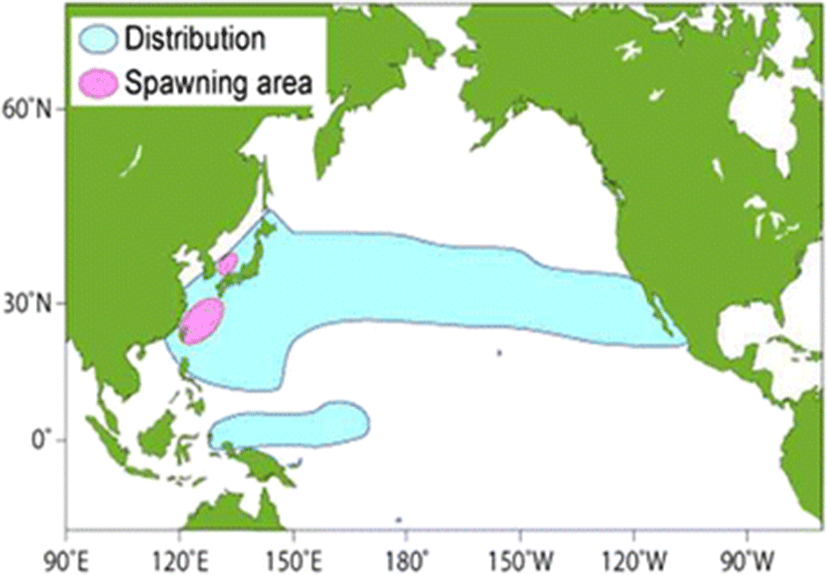
The analysis between the temperature at 50 m and the monthly mean catch of T. orientalis showed that the lower the seawater temperature was, the higher the catch was available. The temperatures in April and June indicated the high catch in 15–16 °C ranges, which were a relatively cool condition, whereas the temperatures in October and December were high (about 20 °C), but catches were low. Schick et al. (2004) inferred that the change of the seawater temperature affecting tuna species was very important. Bayliff (1994) insisted that a temperature range for optimum activity of T. orientalis was 14–18 °C. These results from previous studies are similar to our results representing high catch in the temperature range of 15–16 °C. In the case of CPUE, the mean temperature of areas with high CPUE was also at about 15–16 °C. And in addition, a temperature front (i.e., by colliding two water masses, where the temperature rapidly changed rather than others) could be regarded as another factor affecting the high CPUE in August. Generally, marine populations, not only prey but also predator, were abundant in frontal areas due to the concentrated nutrients. In the previous study, the catch of skipjack and albacore recorded high catches in the frontal area which was related to the temperature gradient and chlorophyll concentration (Laurs et al. 1984; Fiedler and Bernard 1987). Also, Podesta et al. (1993) mentioned that the catch of swordfish was high in SST frontal area. Likewise, the research for other factors such as prey affecting the high CPUE and the catch is necessary. We, however, had difficulty in comparing the relationship between CPUE as well as the catch and the temperature in the whole area or this study area, because the area in which the temperature was observed did not cover the entire area of catch.
According to the result of correlation coefficient analysis between the monthly average of PDOI and the catch, when PDOI had the highest value, the value of the catch was also high. This result meant that SST was low if PDOI indicated a high value. Therefore, the high PDOI resulted in the increasing of T. orientalis catch. In the previous study, the catch of chum salmon caught in the North Pacific Ocean was significantly correlated with the climate indices including PDOI (Kim et al. 2007). In the analysis between the monthly mean length and seawater temperature at 50 m, the higher the temperature was, the smaller the length of T. orientalis became. This result is inferred that small one pretends the warm condition, comparatively. According to Brill and Lutcavage (2001), juvenile of Atlantic bluefin tuna appear to have a clear preference for warm condition in the range of 22–25 °C. In this study, when the temperature was the highest about 21 °C in October, the length of T. orientalis was the smallest. On the other hand, SST was not significantly correlated with the catch and the length. However, according to this analysis, the SST pattern of the entire scale throughout North Pacific Ocean (PDOI) has a significant correlation with the catch. More research is needed to answer this question.
Conclusions
In the relationship between the monthly catch and environmental factors, the catch of T. orientalis was affected by seasonal variation. When the seawater temperature at 50 m was low (i.e., winter and spring), the catch was high. In the case of the PDOI, when the PDOI was high (i.e., winter and spring), the catch was high. In the time series of annual variation, when the SST was comparatively warm (i.e., warm period), the catch of T. orientalis was high. In addition, when the PDOI had low values, the catch was high. The fishing ground had been formed in the east of Jeju Island in the period of this study. The highest catch and catch per unit effort (CPUE) of T. orientalis around Jeju Island occurred either when the seawater temperature at 50 m ranged between 15 and 16 °C or when the catch was taken near the frontal area.








